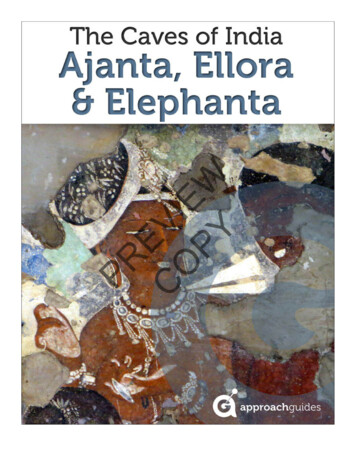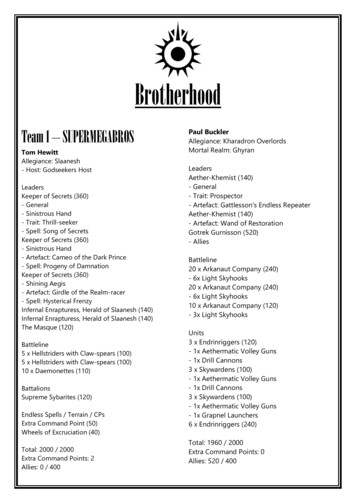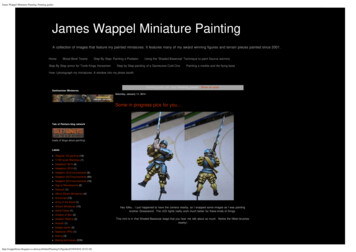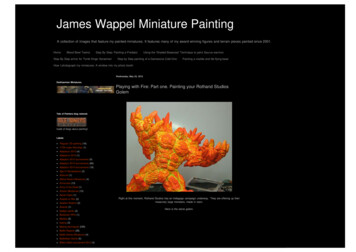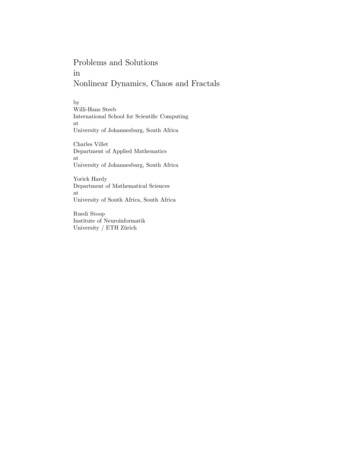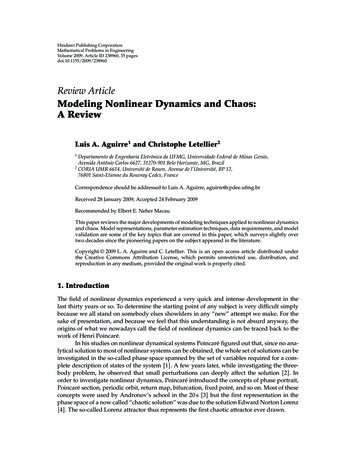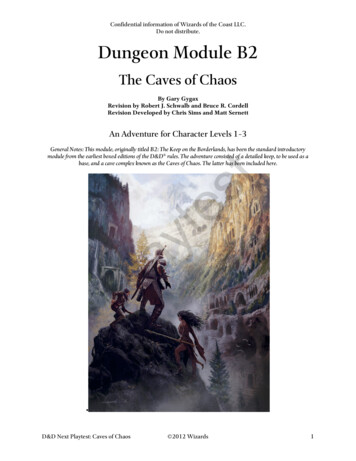
Transcription
Confidential information of Wizards of the Coast LLC.Do not distribute.Dungeon Module B2The Caves of ChaosBy Gary GygaxRevision by Robert J. Schwalb and Bruce R. CordellRevision Developed by Chris Sims and Matt SernettAn Adventure for Character Levels 1–3PlaytestGeneral Notes: This module, originally titled B2: The Keep on the Borderlands, has been the standard introductorymodule from the earliest boxed editions of the D&D rules. The adventure consisted of a detailed keep, to be used as abase, and a cave complex known as the Caves of Chaos. The latter has been included here. D&D Next Playtest: Caves of Chaos 2012 Wizards1
Confidential information of Wizards of the Coast LLC.Do not distribute.What Is This Adventure Testing?Looming WarThe cultists in the Shrine of Evil Chaos (cave K)gathered an army of monsters to the caves,slaughtering all but one group of kobolds that hadlong occupied the ravine. The cult is planning anassault on a nearby city, and the various tribes arepreparing for war in the manner that best suits theirtalents—orcs as shock troops, hobgoblins as infantryand archers, goblins as sappers, and so on. The cityleaders learned of this threat from a former acolytewho regrets joining the cult and seeks a way out.They call on the characters in hopes that a smallgroup can infiltrate the caves and set the fractioustribes against one another so that the army neverreaches the city.testThe Caves of Chaos isn’t meant to be a hard test of theplay balance between characters and monsters.That process is a continuing one as we refine therules for monsters, characters, and encounterbuilding. Although you should keep an eye on howrules interact, this adventure is intended to explorehow well the rules support different styles of play.We’ve created a fairly faithful rendition of theoriginal adventure because we’re hoping to see howplayers use this material. In other words, you canchoose to play in the “theater of the mind” style oras a series of set-piece encounters using a grid andminiatures. The free-form nature of the adventurealso gives many options for play: hack-and-slashbattles, political negotiations, cloak-and-daggerdeceptions, dungeon crawls, guerrilla warfare,comedic interactions, or any mix of those elements.Do the rules allow you the freedom to play theDUNGEONS & DRAGONS game way you like? Howabout the adventure? What elements didn’t workout? What did you change to suit your tastes?a great starting point for applying your creativecontrol. Maybe the different tribes are at war, andthe caves are like trenches in World War I, witheach side of the multifront battle making infrequentattacks and then retreating into its bunker. Perhapsthe caves aren’t as close together as shown on themap, and the canyon is more like a hundred mileslong, so that the different tribes don’t come intocontact with one another as often. Alternatively, youcan collapse one or more caves to create spacebetween them and cut down on the elements youhave to track.Make This Your AdventurePlayThe Caves of Chaos isn’t an adventure in the typicalsense. It doesn’t present a single story, characterhooks aren’t set, and the villains’ actions don’talways have obvious motivations—nor do they workto a common end.With this adventure, you don’t need to stress plotpoints. Characters don’t have to move throughencounters in a specific order. You and your playerscan make the adventure happen however you like.What’s My Motivation?For some players, the existence of dungeons full ofmonsters and treasure is reason enough to get onwith the adventure. If you’re looking for somethingmore, you can link these encounter locations withany story that you think works best. This sectionincludes some suggestions for what’s going on in thecaves and why the characters become involved.You don’t have take any of these ideas as they are;change them or ignore them, and come up withsomething you like better.One way to create a plot for The Caves of Chaos isto ask yourself questions when you read throughthe adventure, then come up with answers. Forexample, you might wonder why the monstersaren’t already at war. The answer to that question isD&D Next Playtest: Caves of ChaosFind the HeirThe tribes took many captives from a caravan raidand have been trading the prisoners amongthemselves as a sort of currency, based on eachone’s ransom value. Unknown to their captors, oneof the prisoners is the heir to a nearby kingdom. Sofar, the other captives have kept this fact a secret,fearing that they might become disposable once theheir is known. The king hires the characters torescue the heir, but he or she won’t leave withoutthe others, or first wants to rescue a love interestheld by another tribe.Under Evil’s ThumbThe various tribes of the caves are slaves to theShrine of Evil Chaos, forced to worship its powerinstead of their own gods. Each month the cultistsdemand tribute, and the tribes engage in acompetition for the best offering. The tribe thatmakes the weakest gift must sacrifice one of itsmembers, whereas the one with the best offeringgains privileges and feasts on goods the cultistsprocure from nearby towns. Striving for ever more 2012 Wizards2
Confidential information of Wizards of the Coast LLC.Do not distribute.wondrous offerings is driving the tribes into afrenzy of raiding each month. The characters arecalled in to discover the reason for the raids anddeal with the problem.Drawn to the Evil EyeDynamic DungeonsOne way to make the adventure more fun is to haveelements change according to the characters’actions. If they kill some hobgoblins and then leave,perhaps they interrupt a funeral feast when theyreturn. If their assault weakens the orcs enough, thecharacters might later find hobgoblins in the orccaves, celebrating their victory. Character actionsmight have important and long-lasting effects.Clearing the kobold caves might provide a fineredoubt for other assaults or turn the complex intoa base for another, tougher group of monsters.testThe ravine was carved in ancient days when a pieceof the eye that Corellon cut from Gruumsh crashedinto the landscape. The various tribes were drawnthere by the eye’s power and mined the rift’s wallsin hopes of finding it. They continue to be held in itsthrall—the orcs in particular seem to be in a trance,breaking into bloody-eyed fury wheneversomething interrupts their search. Any group thatfinds the fragment of Gruumsh’s eye would havetremendous power over the others. A seer who hasdivined this danger approaches the characters witha dire warning: The fragment will be found beforethe next full moon. For the sake of all, thecharacters should be the ones who find it.both to fighting. They can lay an ambush forhunting parties. (Of course, the monsters might getthe hint and start ambushing the characters inreturn.) They might forgo combat entirely and optfor a political approach.This is your adventure. You can make it easier orharder to suit the needs of your story.The Devil You KnowMonster Activity and AdaptationThe ravine is a living environment. Large groups ofintelligent creatures are unlikely to sit in theirrooms, waiting for adventurers to kill them. Half ormore range through the countryside, hunting andforaging, or ambushing travelers on nearby roads.Others might be sent to spy on a rival tribe, tradewith others, raid enemy stores, negotiate with thecultists of the Shrine of Evil Chaos, and so on.Creatures in the ravine have formed alliancesand rivalries. The goblins and hobgoblins are onone side and orcs and gnolls are on the other, forinstance. Others are unallied: The kobolds hope tobe overlooked. Still others are everyone’s enemy:The bugbears bully others and pick off stragglersfrom all conflicts. If characters learn about thesefactions, with careful play, they can use thisknowledge to their advantage.Intelligent monsters adapt their tactics toobserved conduct. For example, if the party usesflaming oil in battle, surviving tribal membersmight use oil later in a similar way. If adventurersconsistently sneak up on the monsters, their targetscould respond by setting alarms and traps. If themonsters observe that characters fleeing fromoverwhelming numbers, the monsters might shoutand make noise to seem more numerous. Monstersthat have been attacked before are likely to be onalert, posting extra guards in entrances or sendingout scouts to watch for enemy approach.PlayThe tribes in the caves have begun raiding nearbysettlements after a long period of relative peace,and the leaders of those communities ask thecharacters to negotiate with the tribal leaders. Thecitizens of the surrounding area are willing to paytribute in return for an end to the attacks and apromise of mutual protection. In fact, a change ofleadership has brought about the raids: The cultistsof Evil Chaos usurped control of the tribes fromtheir old queen, the medusa who is now heldprisoner in area 64. Certain factions of the varioustribes desire the return of the medusa’s rule andpromise to leave the surrounding communities inpeace if the characters can arrange this event. Butothers have benefited from the raids and the shift inpower. Who can be trusted?Free-Form AdventuringMost adventures published for the latest editions ofthe D&D game have encounters tuned for balanceand a structure meant to take the characters fromone set-piece battle to the next. Sometimes, saferesting places were built in at just the right points.Although each cave has a recommended level for aparty of four characters, The Caves of Chaos doesn’twork like such previous adventures.Instead, the characters have the freedom to gowhere they want and pick their own battlegrounds.They can block a cave entrance and try to smokeout the inhabitants. They can trick one tribe intoblaming another for the party’s attacks and set themD&D Next Playtest: Caves of Chaos 2012 Wizards3
Confidential information of Wizards of the Coast LLC.Do not distribute.Changes in TerritoryIf the characters wipe out the denizens of one cave,the returning members might stay to replace thoselost, form a war party to hunt down the characters,or wage open war against another tribe in anattempt to seize new territory. When the charactersclear all monsters out of a cave complex, it remainsdeserted for a time; 1d4 weeks is a typical interval.If the party does not enter the lair again before theend of that period, it might be repopulated. Perhapsthe surviving former inhabitants return or anothermonster moves in. For instance, a troll might takeover the deserted minotaur’s cave (I).Killer EncountersPlaytestThe free-form nature of this adventure can get thecharacters into trouble quickly. Some areas in theravine boast far more monsters than a low-levelgroup of adventurers can handle. Ten orcs can bebig trouble for the party. Pile on another five, andthe adventurers’ careers might end abruptly.Players need to know that some places hold toomany monsters for their characters to defeat all atonce. A nonplayer character (NPC) could warn theparty that the caves house tribes of humanoids,some a score or more warriors strong. You candescribe evidence of the passage of numerousindividuals through the area as the party drawsnear. The noise of many creatures in major tribalareas should also serve as a warning. If all else fails,tell the players that they need to watch their step.Armed with clear information, the players canmake educated decisions before the charactersblunder into an overwhelming encounter.However, even the best-laid plans sometimes gowrong. Encounters that are supposed to be easy canbecome deadly if the dice turn against the players.If the characters get in over their heads, and youwant to avoid killing them all, consider one of theseways to give them an out.Random Encounter: Another group of monstersarrives on the scene, providing a distraction to letthe characters get away. For example, if the koboldshave the characters on the ropes, the sudden arrivalof a flock of stirges could send everyone running.Negotiation: The monsters might be willing tobargain, even if the characters are on the defensive.Perhaps their foes promise to cease the attack if thecharacters are willing to help the tribe raid anothertribe’s cave.Jailbreak: Enemies might capture one or more ofthe characters instead of killing them, and thenbarter them to another tribe. That other tribe mightnegotiate with the captives, or the adventurerscould find a way to escape during the transfer.Alternatively, the captors hold the prisoners forransom. The characters might be able to buy theirfreedom or make a daring prison break.If a tribe demands ransom, the monsters mightrelease one character to fetch the payment. Set thesums low: 2 to 20 gp per prisoner, or a magic itemthat the ransoming tribe might find useful. If theransom is paid, the monsters release the characters.Success at ransoming prisoners might bring fame tothe tribe, increasing its numbers by 2d6 in additionto growing its wealth. The tribe might be extra alertfor 1d4 weeks afterward, in case the adventurersreturn to for revenge or raiders from a rival tribecome to seize the loot.Enemy of My Enemy: Another tribe shows uppartway through the fight, hoping to take advantageof the party’s earlier successes by looting the rivaltribe’s cave. The characters could negotiate analliance with the invaders, set both groups of foesagainst each other, or take advantage of theconfusion to escape.Run Away: Players don’t always agree on whento run from a fight, especially with actions dictatedby the initiative order. A character might want tomake just one more attack or stay behind to makesure someone else can get away. If the players aretalking about running, give them that option,dropping out of initiative order and seguing to achase scene. The characters’ success in escapingshould be dictated by their choices instead of byrules minutia, such as whether one character isslightly slower than another. Do they slam doorsshut as they run through them or use another tacticto slow pursuers? Do they escape one danger onlyto run into more trouble? If they do get out of sight,can they find a place to hole up?D&D Next Playtest: Caves of ChaosRunning the AdventureNo one can predict perfectly how players mightinteract with this material. You’re the DungeonMaster: When the adventure leaves somethingopen to interpretation, fill in the gaps to suit yourneeds. Final decisions are up to you. The guidelinespresented in the adventure offer general directionsfor handling exploration and encounters.Overview MapWoods and contour lines shown on the map aremostly for surface movement reference. 2012 Wizards4
Confidential information of Wizards of the Coast LLC.Do not distribute.WoodsThese groves are tangled and forbidding. Withinthem, characters might encounter monsters fromnearby caves. Woods are difficult terrain (every fivefeet of difficult terrain that you move through costsfive extra feet of movement). Trees and foliagemight also provide cover or concealment.UndergroundThe passages and rooms of the caves might be ondifferent levels. Passages slope between the surfacemap contours, even where no stairways are shown.Except where noted otherwise, interiors are naturalor hewn rock (DC 11 Strength to climb).InteractionYou have been passing through the forest for some time,as it grows denser and gloomier, until the misshapen treesand grasping briars suddenly give way to a ravine. Itswalls—dark, streaked rock mingled with earth—rise steeplyto either side to a height of about 100 feet. Clumps oftrees, some dead, stand even on the slopes. The openingyou are in is about 200 feet wide, and the ravine runs atleast 400 feet west. At varying heights on all sides of theravine are the mouths of caves. The sunlight is dim andthe air is dank, with the oppressive feeling of somethingevil watching. A flock of ravens rises croaking from theground, the terrain magnifying the beat of their wingsand their cries into a horrible sound. Among the litter ofrubble, boulders, and dead wood on the ravine floor, youcan see bones of humanoids, animals, and other creatures.You have discovered the Caves of Chaos.testEach cave includes notes for residents, and theirorganization and conduct, presented in a sidebar atthe start of that section. This sidebar has advice onhow to run the cave environment. The sidebar alsospecifies a level range that tells you how difficultthe cave can be for four adventurers.IntroductionDescriptionsA. Kobold LairA thick clump of trees doesn’t quite hide the black mouthof an opening in the ravine wall.Light: Dim (daylight under the trees) or noneMonsters: Nine kobolds hide in woods aroundthe cave mouth (DC 13 Wisdom to notice; DC 11Intelligence to find). They attack anyone who triesto enter, gaining surprise if they go unnoticed.TasksThis cave is a challenge for a 1st- or 2nd-level party.A higher-level group could trounce the kobolds,unless the monsters are given a chance to organizeagainst the invaders.The kobolds’ main dwelling is area 6. Use koboldsfrom that area to supplement or replenish koboldsin other areas. Subtract those you place elsewherefrom the number in area 6.A kobold that flees another encounter might go toarea 6 to warn the bulk of the tribe. You can have agroup of 1d6 4 kobolds from area 6 sneak outevery few minutes to outflank or ambush intrudersthey know about. At least eight kobolds remain inarea 6 at all times. If the trap lord is killed, thekobolds in area 6 might surrender.Kobolds are notorious for their traps. Especially ifthe characters retreat and return later, you cansupplement existing defenses with simple traps,such as nets and concealed pits. The kobolds areaware of their own traps.ayEach area includes a notation about light (bright,dim, or dark). Some areas include other sensoryinformation, such as noise. Italicized text in eacharea describes the area’s basic contents. Since thecaves are dynamic, monsters might move from oneare to another. Account for sensory information andmonsters in an area when you describe that area.PlSome features indicate related tasks with associatedDCs and relevant ability scores. You can adjust thedifficulty of these tasks as necessary for the abilitiesof your party. This adventure does not define everypossible task or DC, which allows you to rewardcreative play.Checks to detect creatures or objects are usuallyfor active searching (normally using Intelligence).You can allow passive detection, using Wisdom oranother appropriate ability, possibly assigning ahigher DC to the check.Monster StatisticsSpecific areas describe the monsters normallypresent there. The Caves of Chaos Bestiary is whereyou can find the statistics for these monsters,although an encounter area might indicate minorchanges to such statistics.D&D Next Playtest: Caves of ChaosRunning the Kobolds 2012 Wizards5
Confidential information of Wizards of the Coast LLC.Do not distribute.1. Guard Area4. Elite Guard RoomLight: NoneNoise: Intermittent high-pitched talkLight: NoneNoise: Intermittent high-pitched talkA roughly cut tunnel diverges ahead, offering twodifferent paths. Several planks poke out of a pocketchamber to the northeast.This small, simply furnished chamber has a recessedwooden door in the east wall.2. Garbage Heap5. Kobold Lord’s RoomLight: Dim (guttering lantern)Noise (DC 11): Piping argumentsAll manner of savage trophies hang on the walls of thisstifling cave, including furs, tapestries, and old blankets.Heaps of cloth and bits of battered furniture litter thefloor. A lantern on a plank table burns dimly.Monsters: A kobold trap lord lives here with fivekobold attendants.Treasure: The lord wears a necklace with a gem(25 gp), and he has keys to the storage room (area3) and a locked chest (DC 15 Dexterity to unlock,requires thieves’ tools). Hidden in an old blankethanging on the wall (DC 13 Intelligence to find) is50 gp. The chest holds 203 cp, 61 sp, and 22 ep.ayLight: NoneNoise: Squeaking and rustlingSmell: Rotting food, garbage, and wasteMonsters: Four kobold dragonshields live here.Treasure: Each kobold carries 2d10 sp.Development: If combat occurs here, koboldsfrom area 5 join the fight at the start of the secondround of combat.testPit Trap (DC 13 Intelligence to find): A pit ishidden at the junction thirty feet inside theentrance. If the trap goes undetected, eachcharacter in the group’s first rank must succeed ona DC 15 Dexterity saving throw (DC 11 for those inthe second rank) to avoid falling ten feet into the pitand taking 1d6 damage. The pit lid then slams shut(DC 13 Strength to open from inside). Noise fromthe trap attracts monsters from areas 1 and 2.Monsters: Six kobolds are stationed in area 1,which also contains five planks the kobolds use tocross the pit.Treasure: Each kobold carries 1d6 sp.Mounds of garbage and waste foul the area.PlMonsters: Fifteen cave rats and one dire ratburrow in and feed on the refuse here. These petsof the kobolds rush to the sound of the pit closing orbattle nearby.Treasure: The dire rat, a favored pet, wears asilver chain set with semiprecious gems (15 gp).Light: Dim (banked bonfire)Noise: Loud babble of many squeaking voicesA banked bonfire lights this smelly chamber amid heapsof foliage, tattered fabric, and junk of all sorts.3. Food StorageDoor: The door is locked (DC 13 Dexterity tounlock, requires thieves’ tools).Light: NoneSmell: Rotting meatThis storage area is filled with sacks, boxes, barrels, andpiles of unidentifiable stuff, as well as a large wine cask.Rotting, gnawed parts of humanoid bodies litter the floor.Food (preserved and otherwise) is stored here,along with drink. The cask contains vinegary wine.D&D Next Playtest: Caves of Chaos6. Kobold Common ChamberMonsters: Up to forty adult kobolds and eightwhelps (noncombatants) are quartered here. Halfor more of the adults are out foraging, hunting, andraiding, especially at night. At least eight adultkobolds always stay behind to guard the young.Treasure: Any search of the heaps uncovers afine piece of silk worth 15 sp. Each adult kobold has1d4 – 2 sp. 2012 Wizards6
Confidential information of Wizards of the Coast LLC.Do not distribute.B. Orc LairLight: Dim (daylight from cave mouth) or noneNoise: Harsh voices from both directions, louderfrom the westThe northern wall is decorated with the heads of varioushumanoids in various stages of decay. These grislytrophies sit in small niches that dot the wall.Monsters: Three orc guards are stationed here.When they become aware of intruders, they howlto alert others and rush forward into combat.Development: If the watcher (area g) went toarea 8, orcs from there might join those here. If thecharacters pursued the watcher to area 8, the orcshere could rush to attack the invaders there.Treasure: Each orc carries 1d4 ep.8. Guard RoomLight: NoneNoise: Harsh voices to the eastRatty pallets are strewn on the floor, and shabby clothinghangs on wooden pegs set in the wall.Monsters: Three orc guards are stationed here.When they become aware of intruders, they howlto alert others and rush forward into combat.Development: If the watcher (area g) alerts theorc guards here, they rush to find and confront theintruders wherever they are.Treasure: Each orc carries 1d4 ep.testMonster (g): An orc here watches the entrancethrough a small stone opening, making the guard’shead look like one of the others decorating theentry wall. A character who closely examines theheads (DC 13 Intelligence) realizes that this headbelongs to a living creature.If intruders enter, the guard ducks and places agoblin head where hers was (DC 15 Wisdom tonotice the switch during or after the fact). She thenhurries to alert the orcs in area 8. If the charactersare paying attention to the orc head, they notice theswitch the next time they check.Running the Orcs9. Banquet AreaLight: Dim (fire in fireplace)Noise: Many loud, harsh voices to the westSmell: SmokePlayThis cave is a challenge for a 2nd- to 3rd-level party.A 3rd-level group that approaches the cave warilycould find it easy.The orcs’ main dwelling is area 10. Use these orcsto supplement or replenish orcs in other areas.Subtract those you place elsewhere from those inarea 10.If the orcs know about intruders, you can have agroup of 1d3 1 orcs from that area sortie everyfew minutes to confront the invaders. At least threeorcs remain in area 10 at all times to guard theyoung. If intruders flee the lair, orcs from area 10are likely to form a war party and pursue.If on alert due to previous invasion, up to fourorcs from area 10 move to area 9 and hide (DC 15Wisdom to notice, DC 13 Intelligence to find) incorners to await the intruders’ return.If the orc leader is killed, surviving orcs retreat tocave C or cave J, taking their treasure with them.7. Guard RoomLight: Dim (daylight from cave mouth) or noneNoise: Harsh voices to the eastRatty pallets are strewn on the floor, and shabby clothinghangs on wooden pegs set in the wall.D&D Next Playtest: Caves of ChaosA great fireplace in the south wall glows with a smallcharcoal fire. Benches and tables fill the chamber. Onechair, which is larger than the rest and is set at the head ofa big table, is carved with an inscription.The inscription is in Orc. It reads, “For the Leader.”10. Orc Common RoomLight: Dim (smoldering bonfire)Noise: Many loud, harsh voicesSmell: Body odor, rot, and smokeA smoldering fire in the chamber’s center dimly lights achamber full of sleeping pallets and refuse heaps.Monsters: During the day, up to twelve adultorcs and nine whelps (noncombatants) can befound here, resting, or fighting, or bickering overfood and imagined offenses. Even orcs engaged inquiet activities, such as stitching clothes, raise theirvoices to be heard above the general din. Duringthe night, most of these orcs spread out through the 2012 Wizards7
Confidential information of Wizards of the Coast LLC.Do not distribute.ravine and surrounding lands. They leave behind atleast three adults to watch over the young.Treasure: Each adult orc carries 1d4 – 2 ep.11. Storage ChamberDoor: The door is locked (DC 13 Dexterity tounlock, requires thieves’ tools).Light: NoneSmell: Rotting meatNet Trap: Thin wires (DC 15 Wisdom to notice,DC 13 Intelligence to find) run across the passageabout ten feet in from the entrance. When a wire istripped, a weighted net (ten feet wide by twenty feetlong) drops from the ceiling on up to eight creaturesadjacent to it (DC 11 Dexterity saving throw toavoid), and metal pieces tied to the net create aracket that alerts nearby orc guards. Any creatureswho fail the saving throw are restrained (DC 13Strength or Dexterity saving throw ends). Threeorcs from area 14 show up on the next round, andthree orcs from area 15 arrive at the start of thefollowing round.testThe room holds various sorts of dried and saltedmeat (some of it poorly preserved), grain, andvegetables. The weapon racks hold three shields,seventeen spears, and two greataxes. A small cratein the northeast corner contains a light crossbowand sixty bolts.Light: NoneNoise: Occasional commentLight: Dim (daylight from cave mouth) or noneNoise: Harsh voices from both directions, louderfrom the eastTunnels snake off into the darkness in three directions.This rudely cut room is filled with sacks, boxes, andbarrels. Wall racks contain several shields and weapons.12. Orc Leader’s RoomC. Orc LairRunning the OrcsayA carpet covers the room’s floor, and tapestries hang on itswalls. Worn furniture includes a cot and floor pillows.This cave is a challenge for a 2nd- to 3rd-level party.The leader and his orogs can be particularly deadlyfor lower-level groups.The orcs’ main dwelling is area 15. You can usethese orcs to supplement or replenish orcs in otherareas. Subtract any orcs you send elsewhere fromthose in area 15.If the orcs in area 15 are alerted, you can have agroup of 1d6 3 orcs sortie to confront intruders.Four orcs remain in area 15 at all times to guardthe young.If on alert due to previous invasion, five orcs fromarea 15 move to fortify the entrance against furtherassault. They might reset the trap.If this lair’s orc leader is killed, surviving orcsretreat to cave B or cave J, taking everything ofvalue with them.PlMonsters: An orc leader, a cunning brute, liveshere with his four normal orc mates. The leaderuses a battleaxe (1d8 3 slashing damage) andcarries a 1 shield (AC 18).Development: If hard pressed, the leader goesbehind the tapestries on the south wall, opens thesecret door to area 13, and seeks help from thetribe in complex C. Otherwise, the secret door isrevealed only by a search (DC 13 Intelligence).Treasure: In addition to his magic shield, the orcleader has 11 gp in a pouch, and he wears a goldring set with amethyst (20 gp). He has a key to thestorage chamber (area 11) and to the locked ironchest in area t. Each orc mate carries 1d4 gp.Area t: Hidden behind a tapestry on the west wall,this small room holds two suits of chainmail, fourlongswords, and a locked iron chest (DC 15Dexterity to unlock, requires thieves’ tools) thatholds 205 cp, 386 sp, 81 ep, and 13 gp.Niche: A boulder covers a tiny recess in the southwall (DC 13 Intelligence to find; DC 11 Strength toroll the boulder aside). A potion of healing is inside.D&D Next Playtest: Caves of Chaos13. Secret RoomDoors: Secret doors (DC 13 Intelligence to find)allow access to this room from both orc caves.Light: NoneNoise (DC 13): Occasional clickingIn the room’s center are a small table and two chairs. Alarge cracked barrel stands nearby. To one side is a smallwooden chest, above which hang two small shields. Junk isscattered everywhere: broken crates, cracked shields, oldbones, and cast-off boots. 2012 Wizards8
Confidential information of Wizards of the Coast LLC.Do not distribute.Lore: The orc leaders meet here to plan.Monsters: The old barrel is open on its bottom.Nesting under it are two giant centipedes (thesource of the clicking sound), which attack only ifthe bar
The Caves of Chaos isn’t meant to be a hard test of the play balance between characters and monsters. That process is a continuing one as we refine the rules for monsters, characters, and encounter . and have been trading the prisoners among themselves as a sort of currency, based
